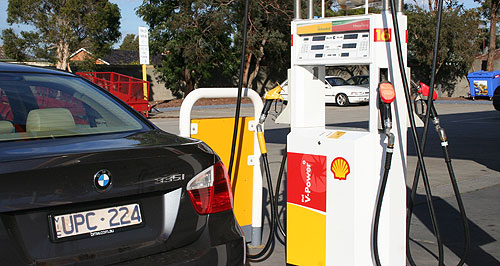Make / Model Search
News - General NewsBetter fuel quality not required, says petrol industryPumped up: The oil and motor industries are at odds over proposed fuel quality improvements. Oil industry refutes claims that fuel quality must improve to meet Euro 5/630 Mar 2010 By TERRY MARTIN THE Australian petroleum industry has told the federal government it does not support changes to the current standards for unleaded petrol, despite auto sector claims that fuel quality will make hi-tech green vehicles more expensive – or prevent them being made available here – as car-makers attempt to meet proposed new emissions standards. The government is now deliberating on a proposed move to the tough Euro 5 emissions standard in 2012, and Euro 6 from 2016, which are the key recommendations in a draft regulation impact statement (RIS) released in January. According to federal transport minister Anthony Albanese, the move could see emissions for all new light vehicles sold in Australia fall by as much as 90 per cent. While the minister has supported the draft RIS and fast-tracking to Euro 5/6 – despite Euro 4 only taking full effect in Australia from July 1 this year – his department has received 24 submissions responding to the proposed changes, including papers from the Federal Chamber of Automotive Industries (FCAI), all three local car manufacturers and the Australian Institute of Petroleum. Submissions from Toyota, Holden and Ford remain confidential, but the FCAI has reiterated comments to GoAuto last month that it does not support the proposed timetable, citing various concerns including the potential negative impact on local engine plants and on the introduction of environmentally friendly models, both local and imported.  Left: Federal transport minister Anthony Albanese. Left: Federal transport minister Anthony Albanese.The peak auto industry body also believes the draft RIS fails to adequately address the disparity between fuel currently available in Australia and the fuel quality required for compliance with Euro 5/6. “Without fuel meeting the necessary fuel quality standards available in the market, the anticipated benefits from Euro 5/6 – that is, reduced vehicle emissions – will not be delivered,” the FCAI said in its submission. Mazda Australia managing director Doug Dickson has also told GoAuto that emerging technology and improved fuel quality were inextricably linked. “The industry is opposed to it (Euro 5/6 timetable) because it overlooks the issue of fuel quality,” Mr Dickson said. “The fuel industry is opposed to any fuel quality increase and that means some engine technologies won’t come, or costs will rise, due to EU5.” The Australian Automobile Association (AAA), which represents all state and territory motoring clubs and supports the introduction of Euro 5/6 “at the earliest possible opportunity”, also highlighted in its submission that the “importance of appropriate fuels to support Euro 5 and Euro 6 vehicle technologies must be recognised”. The AAA said the draft RIS did not fully recognise or consider whether changes would be needed to the Fuel Quality Standards Act, and that motorists would likely bear the brunt of increased costs of petrol with the expectation in the draft RIS that Australia follow Europe and reduce general sulphur levels from 150ppm (as it is for ULP now) to 50 parts per million (in line with PULP) or less. The theory is that sub-50ppm sulphur levels will likely be required to enable the increased durability of catalytic converters demanded by Euro 5/6. In its submission, the AIP has refuted those claims, arguing there are no implications for current fuel standards with the move to Euro 5/6 and that it does not support any further changes to the current Australian standards for petrol. It submitted evidence to show that long-term use of higher sulphur fuel “does not damage catalysts”, that reducing sulphur content of unleaded petrol from 150pp to 50ppm “would not substantially reduce tailpipe emissions”, and that 50ppm PULP is readily available in Australia to cater for new and emerging technologies such as direct-injection engines. It also said that production of ULP with 50ppm sulphur would increase emissions and costs at Australian refineries and would “adversely affect the commercial viability of Australian refineries”. The fuel quality and engine technology issue, as outlined in the draft RIS, has now emerged as a significant factor in the debate over moving to Euro 5/6. The RIS states that it is “widely recognised” that durability of an advanced three-way catalytic converter – which, in combination with the engine management system, is the primary means for controlling emissions – is affected by fuel sulphur. It also says that the durability question becomes more critical in the context of Euro 5/6 as these standards require manufacturers to demonstrate compliance at 160,000km (compared to 100,000km in Euro 4). The RIS also cites evidence that there is “considerable variability” in the sulphur tolerance of advanced emissions control technologies “and their performance at various sulphur levels”. On these, and related issues, the AIP argues in its submission that “there is clear evidence ... to show that most prospective vehicle technologies can operate satisfactorily on the current regular unleaded petrol standard at 150ppm sulphur” and that the “continued existence of a 150ppm ULP standard is not an impediment to the introduction of Euro 5/6”. It also states that “based on available evidence, an advanced three-way catalyst will not be damaged by sulphur and the demonstrated environmental benefits of lower sulphur levels are small”. On the issue of direct-injection engines, the AIP uses the example of Holden’s new SIDI 3.0 and 3.6 V6 engines as being capable of operating satisfactorily on 150ppm ULP. It acknowledges that the need for octane may increase to 95 RON PULP with smaller-displacement engines and the use of other technologies such as turbocharging. However, the institute, which represents BP, Caltex, Mobil and Shell, believes the dominant form of direct-injection technology will be “stoichiometric” – which can run satisfactorily on Australia’s current ULP or PULP – and that demand will remain low for vehicles (generally high performance and luxury models) using “lean-burn” technology, which is recommended to run on 10ppm sulphur levels. It also considered that the next round of improved technologies is likely to be homogenous charge compression ignition (HCCI) or controlled auto ignition (CAI) that combine features of both spark ignition and compression ignition – and cited evidence that these engines have been shown to run successfully “on a variety of fuels”. “Given the likely developments in engine technologies, AIP considers that the technology facilitation benefits have already been achieved by the introduction of the current Australian PULP standard,” it concluded. For its part, the FCAI said in its submission that it “does not agree with the assumption that 50ppm sulphur fuel is adequate to ensure continued in-service compliance with Euro 5 standards, especially the 160,000km durability requirement”. It describes in detail the advantages of 10ppm sulphur in direct-injection engines and argues that “the higher the sulphur level in the fuel, more frequent regeneration is required with a higher CO2 penalty, higher emissions and shorter life of the NOx trap”. It also says that Euro 5/6 introduces additional onboard diagnostics (OBD) requirements, whereas many car brands in Australia currently offer “desensitised” Euro 5 OBD systems due to our higher-than-10ppm sulphur levels in petrol. As a result, the FCAI has called for a review of the Fuel Quality Standards Act. “As the Australian Design Rules are harmonised with the UN ECE Regulations, and more than 80 per cent of vehicles sold in Australia are imported, the FCAI considers that harmonisation of Australian fuel quality standards with the World Wide Fuel Charter (WWFC) and European fuel standards is necessary to achieve the emission and fuel consumption outcomes that the Australian government aims to achieve with the introduction of Euro 5 and Euro 6,” it says. In Europe, the sulphur content of petrol in Europe was set at 150ppm to support the Euro 3 standard, before 50ppm was introduced for Euro 4. Current standards in Europe specify a sulphur limit of 10ppm for both petrol and diesel, although this is understood to primarily support improvements in fuel efficiency rather than air pollution standards such as Euro 5/6. Australia introduced 10ppm for diesel in January 2009, while a year earlier a 50ppm limit was applied to PULP to support Euro 4 petrol vehicles. The 150ppm ULP standard has applied since January 2005. The draft RIS and submissions can be downloaded from the department website at www.infrastructure.gov.au/roads/environment/euro.aspx.  Read more23rd of March 2010  Brits' billion-dollar bankroll to secure auto sectorUK government provides $1 billion in green loan guarantees for Ford, Nissan and GM15th of March 2010  Brits make big inroads into CO2 car emissionsAverage new-car CO2 emissions in UK fall 5.4 per cent to less than 150g/km |
Click to shareGeneral News articlesResearch General News Motor industry news |











Facebook Twitter Instagram